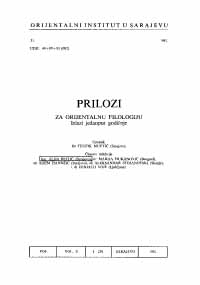BRAČNE USTANOVE U BOSANSKIH MUSLIMANA PRIJE 1946. GODINE
MARRIAGE INSTITUTIONS AND HOW THEY WERE VIEWED BY BOSNIAN MOSLEMS
Author(s): Muhamed HadžijahićSubject(s): Customs / Folklore
Published by: Orijentalni Institut u Sarajevu
Summary/Abstract: The author, having outlined the need for an investigation of the influence of Islam (as well as other religions) on the every-day life of its adherents in individual locations, goes on to consider the question of how certain Islamic marriage institutions were reflected in the every-day life of Bosnian Moslems. In his discussion the author bears in mind earlier developments and asserts that, as a consequence of new social relations even every-day practicees often changed dramatically. Examining the age at which males and Jemales got married, the author maintains that marriage very young was a common phenomenon among Bosnian Moslems. Moslem girls often got married between the ages of 13 and 15. This .is much younger than the corresponding age recorded for Serbs and Croats in central Bosnia in a survey carried out by the famous Yugoslav lawyer Valtazar Bogišić in the 1870's; it is still further below the average marrying age in England in the 18th century. The author mentions the institution of adolescent marriages which were tolerated under certain conditions by Sheriat law and says that, amongst Bosnian Moslems in such cases, there were betrothals arranged by parents living in a new marriage, if, in this new marriage they had children of different sexes from an earlier marriage. Mter such betrothals were arranged the children were not married until they were grown up and then only 'providing both parties still wanted to keep to the arrangement. Marriages between older men and young girls were not so rare; in these cases the girl's motives were largely materialistic. Concerning the influence. of parents in the choice of a marriage partner which, according to Sheriat law and practice in Moslem countries ought to be and was decisive, the author considers that Bosnian MosIems did not feel this influence to anything like the same extent, owing to the institution of ašikovanje (dating and courtship). The paper goes on to deal with endogamous marriages amongst Bosnian Moslems which can, in part, be ascribed to the Sheriat institution of kufv. Endogamous marriage on a class basis was particularly common amongst rural landowning families. Mixed marriages between Moslems and non-Moslems seem to have been more common earlier than they were later OD. In most cases Christian girls manied to Moslems were converted to Islam.
Journal: Prilozi za orijentalnu filologiju
- Issue Year: 1981
- Issue No: 31
- Page Range: 155-168
- Page Count: 14
- Language: Bosnian

